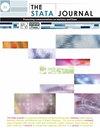rcm:用于回归控制方法的命令
IF 3.2
2区 数学
Q1 SOCIAL SCIENCES, MATHEMATICAL METHODS
引用次数: 2
摘要
回归控制方法,也称为项目评估的面板数据方法(Hsiao,Ching,and Wan,2012,Journal of Applied Econometrics 27:705–740;Hsiao和Zhou,2019,Journal ofApplied Economictrics 34:463–481),是一种在面板数据中进行因果推断的方便方法,该方法利用横截面相关性通过线性回归构建单个治疗单位的反事实结果。在本文中,我们提出了rcm命令,它有效地实现了有或无协变量的回归控制方法。可用的模型选择方法包括最佳子集、套索、前向逐步回归和后向逐步回归,而可用的选择标准包括校正的Akaike信息标准、Akaike消息标准、贝叶斯信息标准、修改的贝叶斯信息标准和交叉验证。估计和反事实预测可以通过普通最小二乘法、套索法或套索后普通最小二乘法进行。对于统计推断,使用假治疗单位的空间内安慰剂测试和使用假治疗时间的时间内安慰剂测试都可以实现。rcm命令生成一系列图形,用于沿途的可视化。我们通过回顾香港和中国大陆之间政治和经济一体化的经典例子(Hsiao,Ching,and Wan,2012)和德国统一(Abadie,Diamond,and Hainmueller,2015,《美国政治学杂志》59:495–510),展示了rcm命令的使用。本文章由计算机程序翻译,如有差异,请以英文原文为准。
rcm: A command for the regression control method
The regression control method, also known as the panel-data approach for program evaluation (Hsiao, Ching, and Wan, 2012, Journal of Applied Econometrics 27: 705–740; Hsiao and Zhou, 2019, Journal of Applied Econometrics 34: 463–481), is a convenient method for causal inference in panel data that exploits cross-sectional correlation to construct counterfactual outcomes for a single treated unit by linear regression. In this article, we present the rcm command, which efficiently implements the regression control method with or without covariates. Available methods for model selection include best subset, lasso, and forward stepwise and backward stepwise regression, while available selection criteria include the corrected Akaike information criterion, the Akaike information criterion, the Bayesian information criterion, the modified Bayesian information criterion, and cross-validation. Estimation and counterfactual predictions can be made by ordinary least squares, lasso, or postlasso ordinary least squares. For statistical inference, both the in-space placebo test using fake treatment units and the in-time placebo test using a fake treatment time can be implemented. The rcm command produces a series of graphs for visualization along the way. We demonstrate the use of the rcm command by revisiting classic examples of political and economic integration between Hong Kong and mainland China (Hsiao, Ching, and Wan 2012) and German reunification (Abadie, Diamond, and Hainmueller, 2015, American Journal of Political Science 59: 495–510).
求助全文
通过发布文献求助,成功后即可免费获取论文全文。
去求助
来源期刊

Stata Journal
数学-统计学与概率论
CiteScore
7.80
自引率
4.20%
发文量
44
审稿时长
>12 weeks
期刊介绍:
The Stata Journal is a quarterly publication containing articles about statistics, data analysis, teaching methods, and effective use of Stata''s language. The Stata Journal publishes reviewed papers together with shorter notes and comments, regular columns, book reviews, and other material of interest to researchers applying statistics in a variety of disciplines.
 求助内容:
求助内容: 应助结果提醒方式:
应助结果提醒方式:


